I was up late last night trying to work on the family line of one of our new members when I hit a snag and realized that we don’t have solid evidence of a particular father/son relationship. I’m still in the process of working this out, but to assist in this I realized that I needed to work out the differences, times, and locations of the various Sheldon’s named Gideon – of which there a surprising number. Thankfully I happen to be descended from two of them myself and they all appear to be from the same branch of the John of Kingston line, all descendants of Thomas Sheldon and Harriet Winters of Dutchess County, New York.
This led me to looking deeper into a particular Gideon, born in Pittsford, Rutland, Vermont in about 1785. And this lead down a new road of discovery that had surprisingly close connections to my own modern family.
At the start of this research dive that I started last night, the only reference to this Gideon that I had was from 19th century historian A. M. Caverly in his book “History of the Town of Pittsford, Vt” (1872). In this book Caverly gives brief biographical notations of the various inhabitants of Pittsford and includes a short notice on Gideon Sheldon and Sarah Waters (grandparents of my subject). He lists their children including the following: “Gideon, Jr.,* moved to Canada, where he m, had a family of children, and d”. Of course the “m” means married and the “d” means died. The *, continued at the bottom of the page, gives us the information on the Gideon born in c1785.
“* Gideon Sheldon, Jr., before moving to Canada, had a son, Gideon, 3d, by Hannah Jackson. This Gideon, 3d, married June 30, 1816, Julia Pearse, and died on the town farm about 1854”.
Caverly’s private notes indicated that Gideon Jr and Hannah Jackson were not married, which he understandably left out of his publication considering the time.
The line I was researching appeared to be from Gideon Jr after his move to Canada where he appears to have had another son that he also named Gideon, so I’m looking for confirmation that this was the same family. I starting looking deeper into Gideon 3d, who stayed back in Vermont, to see if something later in his life might give a clue of confirmation, perhaps some notation to his father or siblings in Canada – unfortunately that has not yet come to light. But what I DID find was very interesting – his pension records for serving in the War of 1812.
From this 66 page application, which was extensive with affidavits from friends and doctors, I learned that Gideon 3rd lived in Pittsford on the property of Ashbel Lee (his step-father who married Hannah Jackson after his birth) at the time that he joined the army in the War of 1812. Prior to his enlistment under Captain Wright of the 30th light infantry, he was described as healthy and robust.
Then, while in service during the winters of 1813 and 1814 he was “on fatigue duty nearly all the time”, in consequence “of fatigue and exposure to severe storms and extreme cold weather, he was seized with inflammatory rheumatism, which continued to increase upon him until his whole nervous system became affected and deranged, and finally terminated in what is called St. Vitus’s dance, which continues to this time” – that being written in 1839, 25 years later.
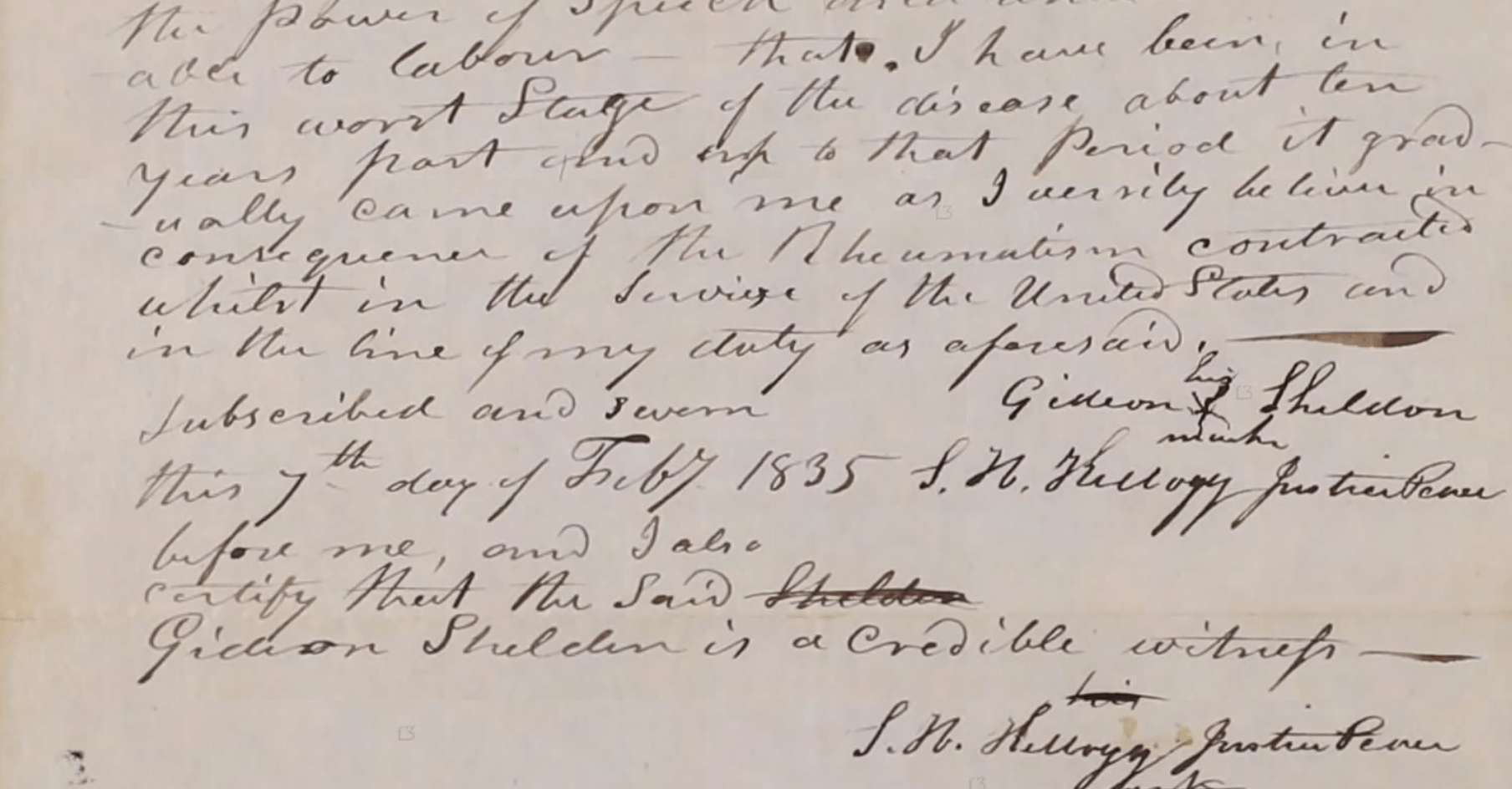
Gideon’s testimony with signature, 1835
Gideon’s own statement was as follows:
I, Gideon Sheldon of Pittsford in the County of Rutland aforesaid being duly sworn do depose and say that during the Winter of A.D. 1813 & 1814 I was a Soldier in Cap’t Wright’s Company of the 30th Regiment U.S. Infantry and was stationed at Plattsburgh; and that I was kept on fatigue duty most of said Winter and that during my services as aforesaid, and in Consequence of my exposure to severe Storms and extreme cold weather, I was seized with an Inflammatory Rheumatism which continued to increase upon me until my whole nervous System became afflicted and deranged and finally terminated in what is called “St. Vitus’ dance” which continues to this time; that I am now afflicted with Said disease in the most aggravated form, being in constant and violent action & motion the whole time, except upon a sleep; which almost deprives me of the power of Speech and renders me unable to labour – that I have been in this worst Stage of the disease about ten years past and up to that Period it gradually came upon me as I verily believe in consequence of the Rheumatism contracted whilst in the Service of the United States and in the time of my duty as aforesaid.
Among the witnesses in the application were several friends who had known him before the war, his wife Julia Pearse whom he married after the war in 1816, a lieutenant in his company during the war, and an assortment of Doctors who disagreed on whether he had contracted the disability during the War or by unrelated means – the primary hold out being Benjamin King, the Surgeon General. The arguments were not sophisticated. In Gideon’s defense doctors noted that the Roman army on the Rhein (centuries earlier) had complained of similar disabilities, with the contrary noting that Gideon was the only soldier in the whole of the army to have fallen to the illness. The debate was drawn out for several years and his petition was not finally approved until 20 July 1840 when he was awarded $257.06, but Gideon had died 8 Apr 1840.
Now the question is, what exactly is this unusual illness called “St. Vitus Dance”? Today it is known as Sydenham’s Chorea and is usually only seen in children for a short period of time. Videos of examples can be found on YouTube. It is not considered fatal or long lasting and seems to only appear after a course of strep throat. And yet 200 years ago Gideon had suffered from the illness for over 25 years, gradually getting worse over time, eventually losing his speech and resulting in his death. Could it be possible that Gideon was misdiagnosed? After all, medical knowledge was still extremely limited in the early 19th century.
Thinking of other possibilities, conditions that involve involuntary movement that gradually gets worse over time and potentially resulting in death – one of the first that comes to mind is Parkinson’s. This is described as “a progressive nervous system disorder that affects movement. Symptoms start gradually, sometimes starting with a barely noticeable tremor in just one hand. Tremors are common, but the disorder also commonly causes stiffness or slowing of movement.” – this certainly seems to match the description given by Gideon and his physicians – and Parkinson’s is caused by nerve cell damage in the brain, which could not be studied in the 19th century.
Parkinson’s Disease was first described as a “shaking palsy” by Dr. James Parkinson in a paper published in London in 1817, but the work was not recognized until Dr. Jean-Martin Charcot took up the research and named the disease after Dr. Parkinson in 1862 – long after Gideon’s diagnosis. Interestingly, Dr. Charcot would also be one of the three doctors after whom CMT (Charcot-Marie-Tooth) was named in 1886, another genetic disease of the nervous system that runs in my own branch of the Sheldon family beginning with my grandfather, Wallace George Sheldon, at birth in 1921, and afflicting 8 members of our immediate family – and it should be noted that we are cousins to the soldier Gideon Sheldon of this article. Is it possible that a single gene passed down through the generations could cause Gideon’s disorder 200 years ago and also effect my family today? Another possibility for Gideon apart from Parkinson’s, and perhaps more likely but still within the same family of nervous disorders, is Lou Gehrig’s Disease (ALS), as this tends to be fatal at a younger age as we see with Gideon.
It would help to know if there was evidence of anyone else in Gideon’s immediate family with a nervous system disorder, and that is exactly what I found tonight! In 1821 Gideon and his wife Julia had a daughter, also named Julia. She never married and seems to have lived the majority of her life in Rutland County, Vermont. She died in Pittsford on 25 Jul 1872 at the age of 51. The cause of death was noted as “St Vitus Dance”, the same illness as her father, which tells us that it was in fact hereditary and not something he had contracted during the course of his service in 1813/14.
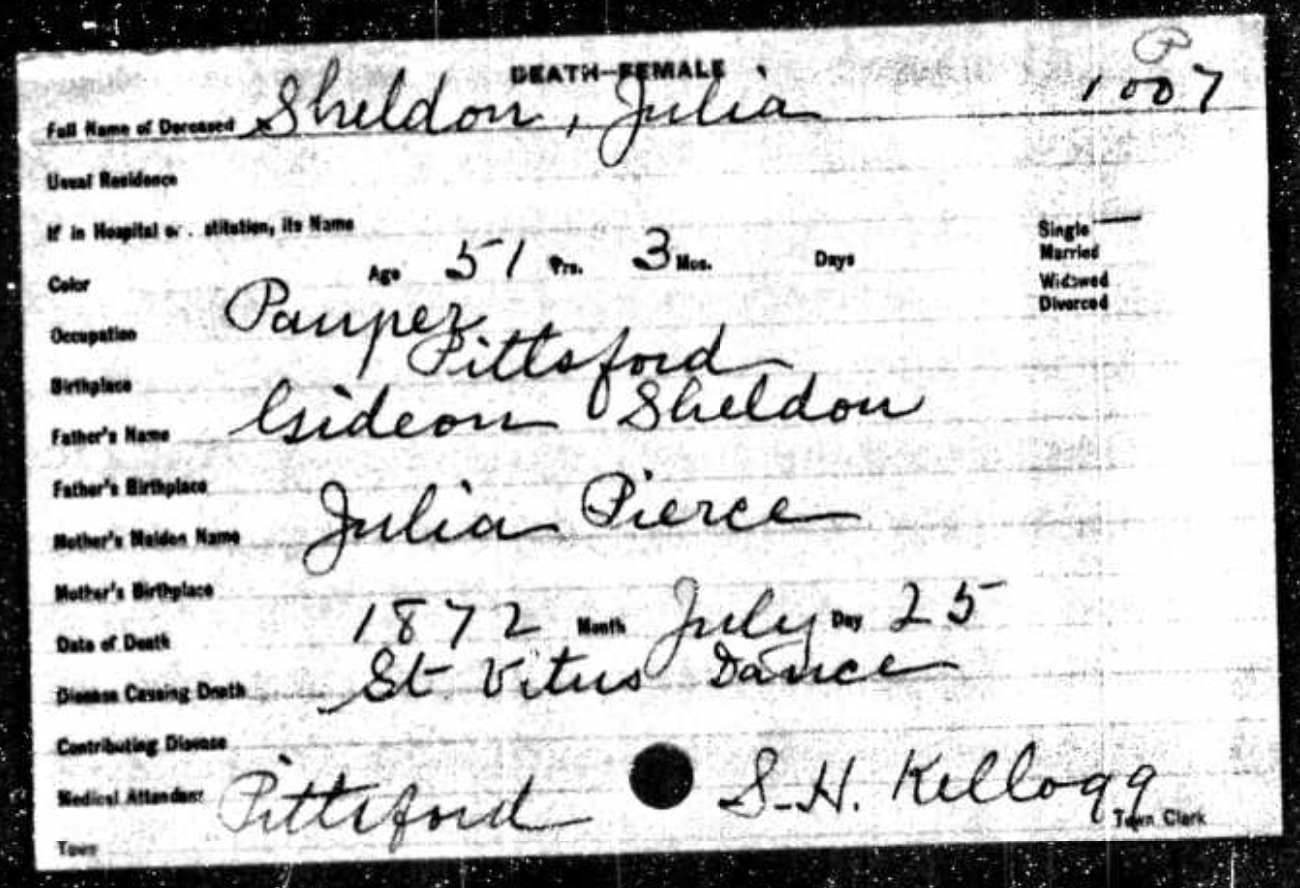
Sadly, to wrap up this particular branch of the family before moving on, it seems that Gideon and his small family had a rough time of it. He was disabled the majority of his life, particularly beginning in about 1826. He began his petition for a pension in 1833 but didn’t file until 1835 and it was not approved until a few months after his death. His payment would have gone to his wife and daughter which would have sustained them for some time, but Julia did remarry to a Mr. Cliflin at some point (I have not yet found a marriage record). In 1859, as Mrs. Juliann Cliflin of Brandon, Rutland County, she seems to have been single again and filed for a widow’s pension from Gideon’s service – but her case was denied. In the 1860 census she, as Julia Cliflin (no husband listed), and daughter Julia Sheldon, are both living together with the occupations of “Wash Woman”. Julia Cliflin died in Brandon in Feb of 1870 of consumption, and later that year, in August, her daughter Julia Sheldon is listed as living in the Poor House in Pittsford. On her death record two years later Julia Sheldon was listed as “pauper”. This is perhaps evidence of the lack of treatment and care of the disabled in 19th century America.
Looking to the future, it may be interesting to see if it’s possible for Gideon and Julia’s case of “St Vitus Dance” (or Parkinson’s/ALS?) may have a genetic connection to the Charcot-Marie-Tooth disease in their cousins 200 years later – all are rare disorders that effect the nervous system, but they do also have significant differences. CMT is not usually fatal and is a deterioration of the nerves rather than causing the spasms characteristic of St Vitus Dance, Parkinson’s, and ALS. But could it be that all of us carry a marker that makes us more susceptible to these types of disorders in the nervous system? It may be an interesting question to pursue.

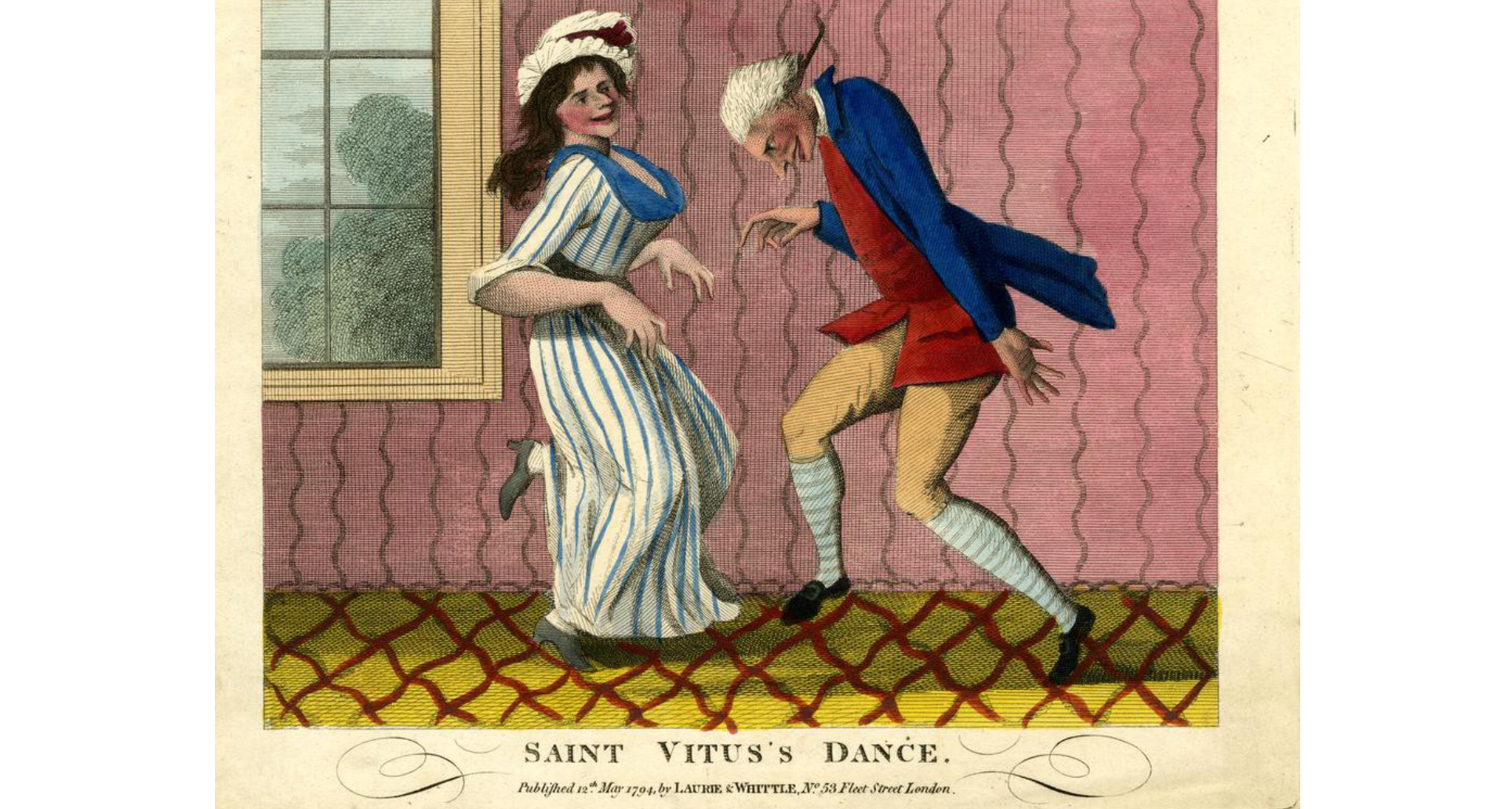
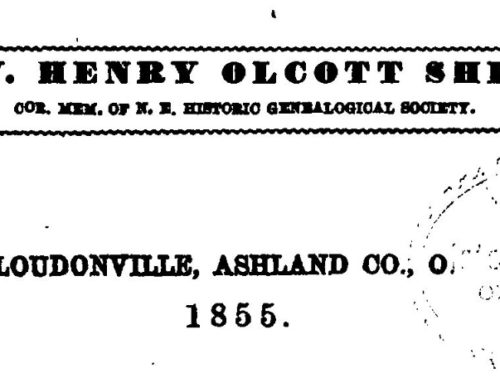


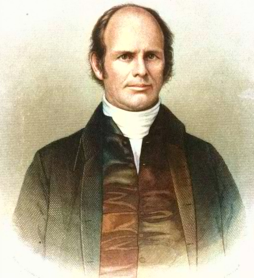

Leave A Comment
You must be logged in to post a comment.